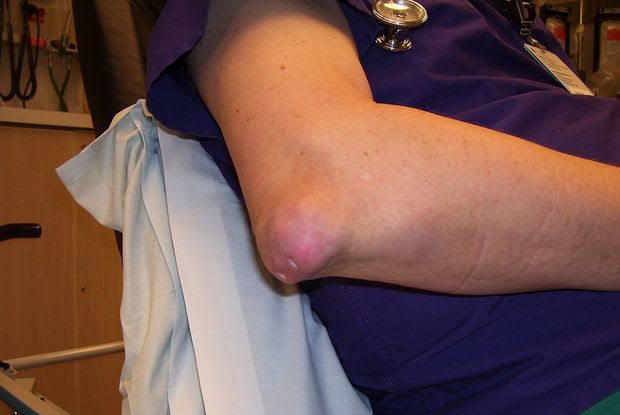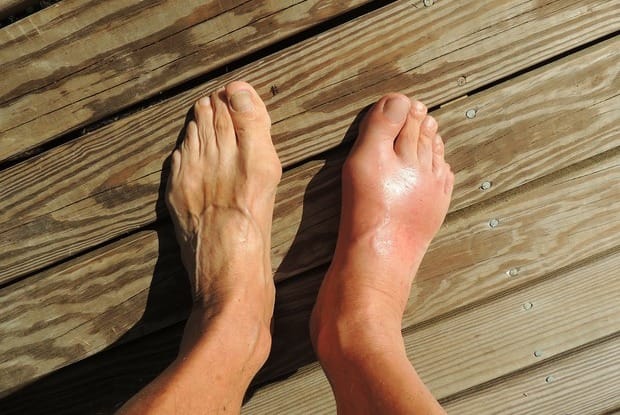Table of Contents
Understanding Gout
Gout was once referred to as the “disease of kings.” People once linked this painful inflammatory condition to those who overindulged in food and wine, but modern science finds this condition far less regal. An attack of gout can leave a person feeling uncomfortable with lingering pain for days to weeks. This unpleasant condition affects millions of people in the United States.
Gout is the most common type of inflammatory arthritis in men. This illness occurs when there is a buildup of uric acid in the blood. This acid leads to urate crystal formation on joints in the body, most commonly the big toe, ankles, knees, elbows, wrists, and fingers. These crystals cause disabling pain and swelling in the affected joints. [1]
a. Symptoms of gout
Gout symptoms typically occur without warning, usually in the middle of the night. The most common symptoms include swelling, redness, discomfort, and inflammation. The pain can often be excruciating and last for several days to weeks.
Gout can be challenging to diagnose, and each treatment plan must be tailored specifically to each patient. Medications like Colchicine are commonly prescribed to treat symptoms of gout. If left untreated, gout can wreak havoc on the rest of the body and cause long-lasting health problems. Particular food and drinks cause the formation of urate crystals, so avoiding foods like red meat and drinks like beer helps to reduce the symptoms of gout. Read on to learn more about health complications that can occur with gout. [2]
Tophaceous Gout
If you have repeated gout flare-ups or high uric acid levels for several years, you may develop tophaceous gout. This type of gout leads to the development of tophi. Tophi are hard uric acid deposits that form under the skin and form chalky lumps. Tophi usually occur near the elbow, finger, or toe joints.

Once tophi develop, permanent bone and cartilage damage can occur. The tophi deposits can also pop through the skin and become infected during a gout attack. With proper treatment, tophi can dissolve and disappear completely. If you cannot take uric acid-lowering medication, then your doctor may recommend surgery to improve the mechanical problems of your joints. Tophi doesn’t occur with every gout patient. Those at risk for tophaceous gout can include:
- People taking uric-acid lowering medications
- Postmenopausal women who take diuretics
- Organ transplant recipients who are receiving medications to prevent transplant rejection [3]
Kidney Problems
Kidney disease and gout are often linked. Kidney disease can lead to gout, and gout can predict the development of kidney problems. The kidneys are affected because uric acid is filtered through the kidneys. Uric acid is a waste product, and issues occur when the kidneys cannot filter out this acid as well as they should. When this acid cannot be adequately filtered properly, then it builds up, and gout occurs.
The American Kidney Fund says that 1 out of 10 people with kidney disease have gout, and an even higher rate of people with gout have kidney issues. Gout is often an early warning sign of kidney disease. Damage to the kidneys can occur when the urate crystals pass through the kidneys and cause scars. If this type of injury occurs over a long period, it can lead to kidney disease and failure. A high concentration of urate crystals can also form kidney stones, which can interfere with renal function. [4]
Treating kidney issues with gout can be a challenging process because nonsteroidal anti-inflammatory drugs (NSAIDs) are used to relieve pain associated with gout. This poses a problem because prolonged use of NSAIDs can lead to kidney disease. It is vital to maintain a healthy diet and exercise routine to prevent further complications. [4]

Heart disease
Recent studies from the American Heart Association have found conclusive links between gout and heart issues. Researchers from Duke University studied 17,000 patients, 1,400 of which had gout and cardiovascular risk factors. This study took place over 6.4 years. Researchers found that the patients with gout and those who developed gout over the study had a twofold increased risk of heart failure. [5]
The exact link between heart issues and gout is not definitive. Still, many scientists believe that the inflammation associated with gout affects not only joints but many organs in the body, especially the heart. Problems with gout can also lead to high blood pressure, coronary artery disease, as well as heart failure. Some people may only have gout attacks once a year, but that does not lower the risk of developing heart complications. It is essential to seek treatment for gout immediately to ensure good cardiovascular health. [5]
Joint deformity
A patient with gout should keep an eye on their joint health, especially if they notice their gout condition worsening. Your gout may be becoming more severe if you start to experience flare-ups in other parts of the body than the original affected joint, kidney problems, and bumps under the skin (tophi).
When uric acid crystals form on the joints, it can erode the joint tissues. The formation of tophi can also lead to joint destruction if the tophi bumps are not treated. Gout is a form of arthritis, so bone erosion and cartilage loss can cause lingering pain as well as joint deformity. [6]

Type 2 Diabetes
Diabetes and gout can often predict the other. If you have gout you are more likely to develop diabetes and vice versa. Type 2 diabetes occurs when the body does not make enough insulin to control the body’s blood sugar levels. The connection between the two conditions is not fully understood, but people with type 2 diabetes often have high levels of uric acid in the blood. This is typically due to extra fat on the body. If you have weight-related type 2 diabetes, then it makes it harder for your kidneys to get rid of uric acid, which may result in gout.
One study done by the Framingham Heart Study found that those with higher uric acid levels in the blood were more likely to get type 2 diabetes. Another study found that women with gout were 71 percent more likely to get diabetes, and men were 22 percent more likely. [7] The risk factors for developing gout and diabetes include:
- Drinking too much alcohol
- Being overweight or obese
- A family history of either condition [7]
Treatment
Your treatment plan for gout will depend on your current medical condition, and if you have any of the illnesses listed above. Typically, your doctor will prescribe NSAIDs for general pain relief. NSAIDs, like ibuprofen, will help with the aches and pain that occur with gout.
In more severe cases, you may be prescribed Colchicine or corticosteroids. Colchicine is specifically designed to target the pain associated with gout. It is generally effective but may cause nausea and diarrhea. Many gout-sufferers find these side effects worth the effective pain relief this drug provides.
Corticosteroids can also help control inflammation and pain. These drugs can be prescribed in pill form or administered through injections directly to the affected joint. It is essential to keep all doctor’s appointments and maintain communication with your healthcare team to avoid further complications of gout. [8]
The content in this article is intended for informational purposes only. This website does not provide medical advice. In all circumstances, you should always seek the advice of your physician and/or other qualified health professionals(s) for drug, medical condition, or treatment advice. The content provided on this website is not a substitute for professional medical advice, diagnosis or treatment.
